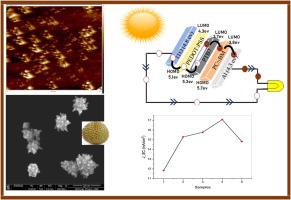Solar Energy ( IF 6.0 ) Pub Date : 2020-12-29 , DOI: 10.1016/j.solener.2020.12.010 Muheeb Ahmad Alkhalayfeh , Azlan Abdul Aziz , Mohd Zamir Pakhuruddin

|
Organic semiconducting polymers are useful in several photonic applications due to their tunable optical and electronic properties and ease of fabrication. However, due to the short exciton diffusion length and low carrier mobility of polymer solar cell (PSC) materials, their power conversion efficiency (PCE) is comparably lower than their inorganic counterparts. Therefore, this study introduces plasmonic effects into these organic polymer-based solar cells by incorporating [email protected] nanoparticles (NPs) to improve their performance. The plasmonic NPs ([email protected] durian-shaped NPs), which can be placed in the hole transport layer (HTL) of the PSC, scatter light into the active layer thereby increasing the optical path length of the incident light, leading to higher absorption and short circuit current density of the PSCs. The shape of nanoparticles is an important factor since it directly affects surface plasmonic resonance (SPR) and the incident light’s scattering. The proposed [email protected] NPs (with many sharp spikes) confirmed the effect of small radii of the spike ends of the durian-shaped NPs on the performance PSCs. The results reveal that the embedded [email protected] NPs improve the electrical properties of both the active layer and HTL in PSCs. In more detail, [email protected] NPs create plasmon-electrical effects which shorten transport path length of the low-mobility holes and lengthen that of high-mobility electrons for better-balanced carrier collection. Meanwhile, the resistance of HTL is reduced by [email protected] NPs. Therefore and PCE of up to 17 mA/cm2 and 3.73%, respectively, implies a 44.4% improvement in short-circuit photocurrent density and 49% enhancement of the power conversion efficiency compared to the reference cell.
中文翻译:

通过将Au @ Ag NPs榴莲形状嵌入缓冲层中来提高聚合物太阳能电池的效率
有机半导体聚合物由于其可调节的光学和电子特性以及易于制造而可用于多种光子应用。但是,由于聚合物太阳能电池(PSC)材料的激子扩散长度短且载流子迁移率低,因此其功率转换效率(PCE)低于无机材料。因此,这项研究通过掺入[电子邮件保护的]纳米粒子(NP)来改善其性能,从而将等离子体效应引入这些基于有机聚合物的太阳能电池中。可以放置在PSC的空穴传输层(HTL)中的等离子NP(受电子邮件保护的榴莲形NP)会将光散射到有源层中,从而增加了入射光的光路长度,从而导致PSC的吸收和短路电流密度。纳米颗粒的形状是一个重要因素,因为它直接影响表面等离子体共振(SPR)和入射光的散射。提议的[受电子邮件保护的] NP(具有许多尖峰)证实了榴莲形NP尖峰末端的小半径对性能PSC的影响。结果表明,嵌入式[受电子邮件保护] NP可改善PSC中有源层和HTL的电性能。更详细地讲,[受电子邮件保护的] NP会产生等离激元电效应,从而缩短低迁移率空穴的传输路径长度,并延长高迁移率电子的传输路径长度,以实现更好的平衡载流子收集。同时,[电子邮件保护] NP降低了HTL的抵抗力。因此 提议的[受电子邮件保护的] NP(具有许多尖峰)证实了榴莲形NP尖峰末端的小半径对性能PSC的影响。结果表明,嵌入式[受电子邮件保护] NP可改善PSC中有源层和HTL的电性能。更详细地讲,[受电子邮件保护的] NP会产生等离激元电效应,从而缩短低迁移率空穴的传输路径长度,并延长高迁移率电子的传输路径长度,以实现更好的平衡载流子收集。同时,[电子邮件保护] NP降低了HTL的抵抗力。因此 提议的[受电子邮件保护的] NP(具有许多尖峰)证实了榴莲形NP尖峰末端的小半径对性能PSC的影响。结果表明,嵌入式[受电子邮件保护] NP可改善PSC中有源层和HTL的电性能。更详细地讲,[受电子邮件保护的] NP会产生等离激元电效应,从而缩短低迁移率空穴的传输路径长度,并延长高迁移率电子的传输路径长度,以实现更好的平衡载流子收集。同时,[电子邮件保护] NP降低了HTL的抵抗力。因此 [电子邮件保护] NP产生等离子电效应,从而缩短了低迁移率空穴的传输路径长度,并延长了高迁移率电子的迁移路径长度,从而实现了更好的平衡载流子收集。同时,[电子邮件保护] NP降低了HTL的抵抗力。因此 [电子邮件保护] NP产生等离子电效应,从而缩短了低迁移率空穴的传输路径长度,并延长了高迁移率电子的迁移路径长度,从而实现了更好的平衡载流子收集。同时,[电子邮件保护] NP降低了HTL的抵抗力。因此与参比电池相比,PCE和PCE分别高达17 mA / cm 2和3.73%意味着短路光电流密度提高44.4%,功率转换效率提高49%。











































 京公网安备 11010802027423号
京公网安备 11010802027423号